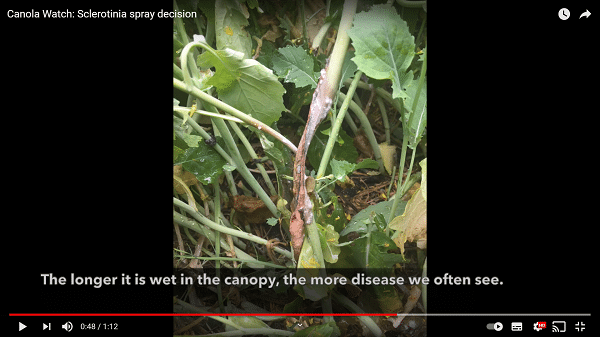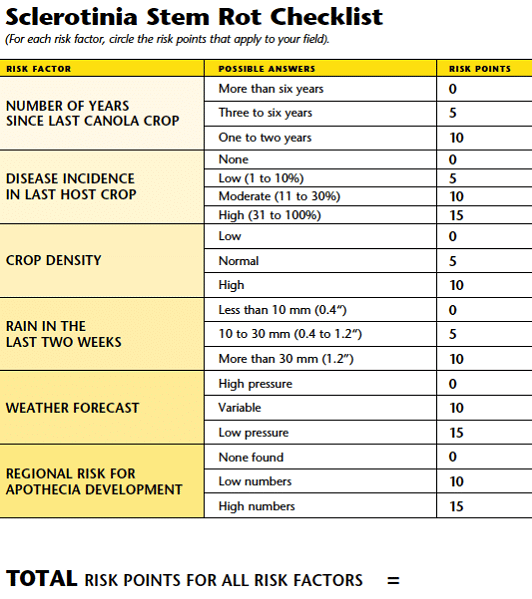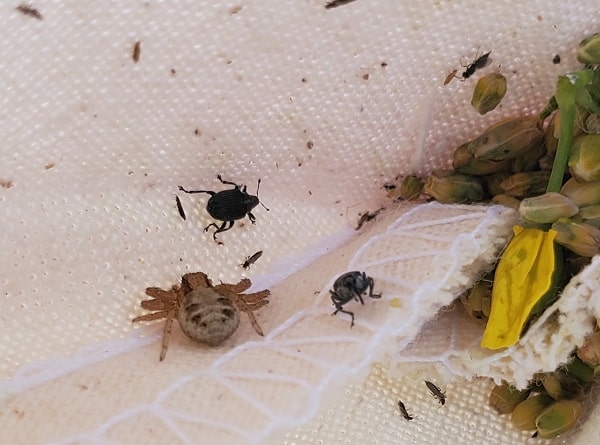

Assess risk before spraying for sclerotinia
After weeks of widespread hot, dry weather, some parts of the Prairies recently received a moderate amount of precipitation. However, moisture can create new issues and one thing on producers’ minds is whether to late-spray for moisture-loving sclerotinia stem rot: should I spray, when should I spray and how much? The first step is to assess the risk. It may be helpful to use the disease triangle (host, pathogen and environment). The sclerotinia spraying checklist above is a good starting point for deciding whether or not to spray. Timeline for infection can help you decide whether you still have a spraying window. This Canola Encyclopedia entry is an excellent resource for general management of the disease, including appropriate fungicides. This page from Manitoba Agriculture offers a profitability analysis of spraying for the disease (click the “Sclerotinia Treatment Decision Tool – Canola” link under “Crops”). Finally, if you have any doubts about any sclerotinia-fighting product, run a test strip.
Check your crop for heat damage
Although many areas of the Prairies have received a respite from the heat, summer is still upon us and it’s crucial to check for symptoms from excessive heat in canola plants. One of these symptoms can be missing pods. Hot days (28-30 C and up) from bud to mid-flowering stages can have a significant effect on canola yield, reducing flower reproductive function and resulting in blanks along the stem. However, there are other reasons for missing pods you’ll want to rule out before presuming heat as the cause. Speaking of heat-related crop ailments, heat blast — the tendency for plants to become so stressed from heat that they “blast” and abort pods — can be a real problem when the mercury hits above 30 C. This Real Agriculture article offers tips on what to do about it.

What’s in your sweepnet today?
Depending on where you are in western Canada, the answer to the question above is probably lygus bugs, cabbage seedpod weevil, diamondback moth larvae and/or grasshoppers (a Prairie-wide prediction map is available here). But in the process of finding these pests, you may also discover some beneficial insects which aid the canola-growing process, including bees (for a wealth of information on beneficial insects and their management practices, visit https://fieldheroes.ca/fieldguide/). This article looks at how useful pollination is under several sub-optimal conditions. Bee BMPs presents some key tips for managing bees. Finally, keep your personal safety in mind when spraying for not-so-useful insects. Check out this guide to pesticide safety in Canada.
Late-window herbicide: better late than never
Wind and rain can push back herbicide spraying to the point of yield loss, but late-window applications can still be worth it. While some yield loss may be permanent, spraying late can still make a big difference compared to doing nothing. Benefits can include stopping yield loss, minimizing weed seeds from entering the weed seedbank and improving crop harvestability. This article features best practices for late herbicide applications including timing, canola staging and more. To end on a positive note, although this has been a rough year so far for many canola producers, this Country Guide article on “the great canola yield rebound of 2015” may offer some cause for hope.
